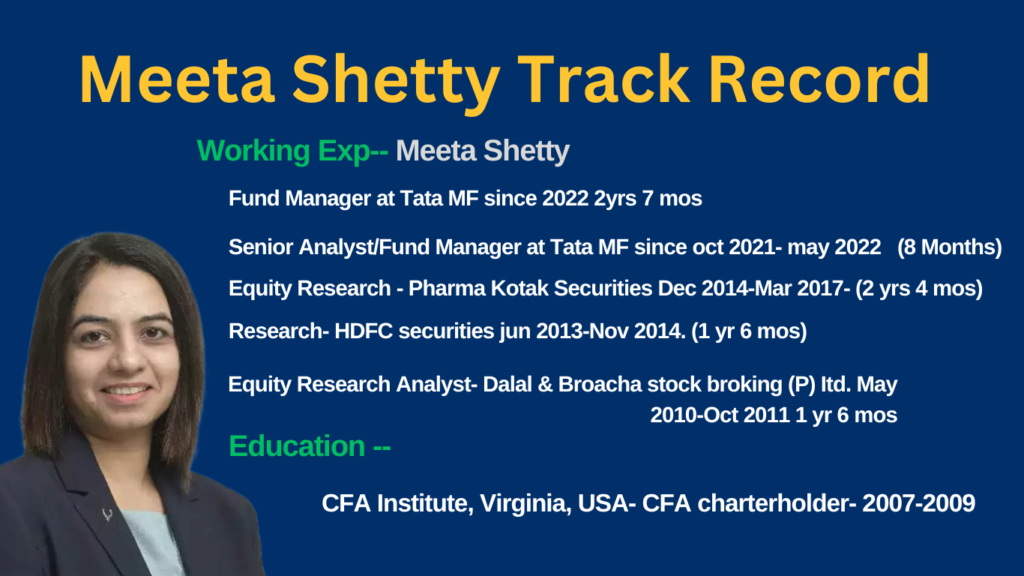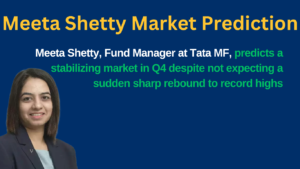Meeta Shetty, Fund Manager at Tata MF, predicts a stabilizing market in Q4 despite not expecting a sudden sharp rebound to record highs

Tata MF’s Meeta Shetty predicts a gradual market rebound, focusing on earnings growth rather than a sharp market correction, despite the recent 10% drawdown, indicating positive momentum building. Earnings will be crucial to that market recovery, Shetty said. With more than 16 years of experience in the field, Meeta Shetty thinks that following poor Q2 earnings, there would probably be a modest recovery in Q3, with a more significant recovery expected to occur in Q4FY25. “I don’t think FY25 earnings projections will be drastically lowered. According to the CFA Chartered Holder, FY26 earnings should show a greater growing trajectory.

Given their track record of earnings, are pharmaceutical companies currently valued fairly?
Over the past two to three years, the pharmaceutical industry has experienced a notable resurgence, especially in the US generic market, which has contributed to increased growth and profitability. The industry has demonstrated consistent earnings growth and has outperformed. It is now comparatively more properly valued, even though it is still trading at a 50–55 percent premium to the Nifty, which is still less than the 80 percent premium it had in 2015. The sector is still a desirable long-term investment, even though growth may slow down a little. The profits performance has held up nicely. That steadiness is reflected in the current valuation.
Equity markets are showing strong flows, especially after a 10% drawdown. Despite not expecting a sharp rebound to record highs immediately, positive momentum is building. The key to recovery is earnings growth, with a clearer picture expected in Q4FY25. Long-term focus remains on earnings rather than short-term market movements.
In the current market correction, strong potential exists in consumer discretionary and staples, particularly for three to five-year investments. Urban consumption has been weak, but recovery in rural consumption makes these sectors attractive for long-term growth and consumption recovery.
The author expects a partial recovery in Q3 and a substantial recovery in Q4FY25, despite weak Q2 results. They believe medium-term earnings growth is more promising for FY26, with clearer signs of recovery in sectors like consumption, infrastructure, and industrials. Moderation may occur in the near term.
The industrial sector is currently mixed, with some sectors trading at high valuations. However, attractive opportunities exist in sub-segments like roads and power transmission, which could benefit from government spending and infrastructure growth. The investor’s approach is selective, positioning funds with a neutral to slightly overweight stance.
In 2025, do you think the IT industry will yield substantial returns?
The IT sector’s valuations are nearing highs, suggesting limited room for expansion. However, solid earnings growth over the next two to three years should drive returns, primarily from earnings rather than multiple expansion.
What plan do you have for launching the Innovation Fund? Will it be a major trend in the years to come?
Indeed, we think innovation is a strong theme with a lot of promise for the years to come, and we can’t wait to share it with our investors. The Tata India Innovation Fund’s approach focuses on identifying businesses that are using innovation to bring about either revolutionary or gradual transformations. Our strategy focuses on two types of innovation: incremental innovation, which introduces small but significant improvements to current goods or services, such as improvements in the driving experience or the switch from thermal to renewable power, and breakthrough innovation, which frequently originates from smaller, tech-driven businesses with extensive R&D.
These two facets of innovation
- The significant changes and the continuous &
- Evolutionary advancements
Are changing sectors and opening doors that may lead to sustained expansion. We anticipate that these developments will be crucial to economic growth and profitability in all industries over the course of the next ten to twenty years. By building a portfolio of equities that complement these innovation-driven themes, we want to seize these opportunities with this fund and eventually achieve sustainable alpha production. This strategy makes it possible to access the structural growth potential of businesses that are at the forefront of innovation, which makes it an intriguing issue for the years to come.